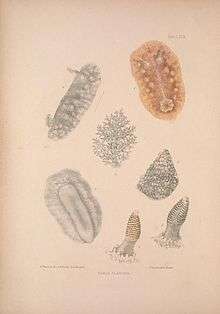Geitodoris planata
| Geitodoris planata | |
|---|---|
 | |
| Dorsal view of Geitodoris cf. planata | |
| Scientific classification | |
| Kingdom: | Animalia |
| Phylum: | Mollusca |
| Class: | Gastropoda |
| (unranked): | clade Heterobranchia clade Euthyneura clade Nudipleura clade Nudibranchia |
| Superfamily: | Doridoidea |
| Family: | Discodorididae |
| Genus: | Geitodoris |
| Species: | G. planata |
| Binomial name | |
| Geitodoris planata (Alder & Hancock, 1846)[1] | |
| Synonyms[2] | |
|
Doris planata Alder & Hancock, 1846 | |
Geitodoris planata is a species of sea slug or dorid nudibranch, a marine gastropod mollusk in the family Discodorididae.
Taxonomy
It was originally described from Europe. Caribbean populations are morphologically similar but almost certainly distinct.[5] Alvim & Pimenta (2013)[6] regarded Caribbean animals as Geitodoris pusae (Er. Marcus, 1955), but no molecular studies have been conducted to compare animals from both sides of the Atlantic Ocean.[5] Further research is necessary to clarify the status of this species.[5]
Distribution
Distribution of Geitodoris planata includes Mediterranean Sea, North Atlantic Ocean, North Sea, Western Atlantic: New Jersey, St. Lucia and Panama.[5]
The type locality is "Lamlash Bay", Isle of Arran, Scotland.[1]
Description

The body is oval.[5] Mantle is rigid.[5] Dorsum is covered by rounded, stalked tubercles.[5] Background color is grayish-brown with some dark brown irregular patches.[5] The color fades and becomes more translucent towards the mantle margin.[5] Larger tubercles surrounded with opaque white pigment.[5] Rhinophores and gill are usually the same color as the dorsum with white tips.[5] The maximum recorded body length is 65 mm.[7][5]
Ecology
Minimum recorded depth is 91 m.[7] Maximum recorded depth is 267 m.[7] But this species apparently live also in more shallow water.[5] It was found in coral rubble in a predominately sea grass habitat in Panama.[5]
Its prey include sponges Hemimycale columella and Hymeniacidon perlevis.[8]
References
This article incorporates Creative Commons (CC-BY-4.0) text from the reference[5]
- 1 2 Alder J. & Hancock A. (1846). "Notices of some new and rare British species of naked Mollusca". Annals and Magazine of Natural History 18: 289-294, page 292, plate 4.
- ↑ Gofas, S. (2004). Geitodoris planata (Alder & Hancock, 1846). In: MolluscaBase (2016). Accessed through: World Register of Marine Species at http://www.marinespecies.org/aphia.php?p=taxdetails&id=139580 on 2016-10-29
- ↑ Verrill A. E. (1880). "Notice of the remarkable marine fauna occupying the outer banks off the southern coast of New England". American Journal of Science 3(20): 390-403. page 399.
- ↑ Risso A. (1826-1827). "Histoire naturelle des principales productions de l'Europe Méridionale et particulièrement de celles des environs de Nice et des Alpes Maritimes". Paris, Levrault: 4: page 33, plate 2, figure 15.
- 1 2 3 4 5 6 7 8 9 10 11 12 13 14 15 Goodheart J. A., Ellingson R. A., Vital X. G., Galvão Filho H. C., McCarthy J. B., Medrano S. M., Bhave V. J., García-Méndez K., Jiménez L. M., López G. & Hoover C. A. (2016). "Identification guide to the heterobranch sea slugs (Mollusca: Gastropoda) from Bocas del Toro, Panama". Marine Biodiversity Records 9(1): 56. doi:10.1186/s41200-016-0048-z
- ↑ Alvim J & Pimenta A. D. (2013). "Taxonomic review of the family Discodorididae (Mollusca: Gastropoda: Nudibranchia) from Brazil, with descriptions of two new species". Zootaxa 3745(2): 152–198. doi:10.11646/zootaxa.3745.2.2.
- 1 2 3 Welch J. J. (2010). "The “Island Rule” and Deep-Sea Gastropods: Re-Examining the Evidence". PLoS ONE 5(1): e8776. doi:10.1371/journal.pone.0008776.
- ↑ McDonald G. R. & Nybakken J. W. (1997). "List of the Worldwide Food Habits of Nudibranchs". The Veliger 40(2). UC Santa Cruz: Retrieved from: http://escholarship.org/uc/item/0g75h1q3